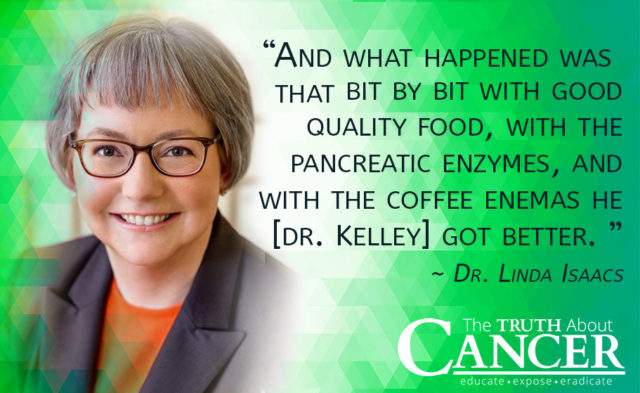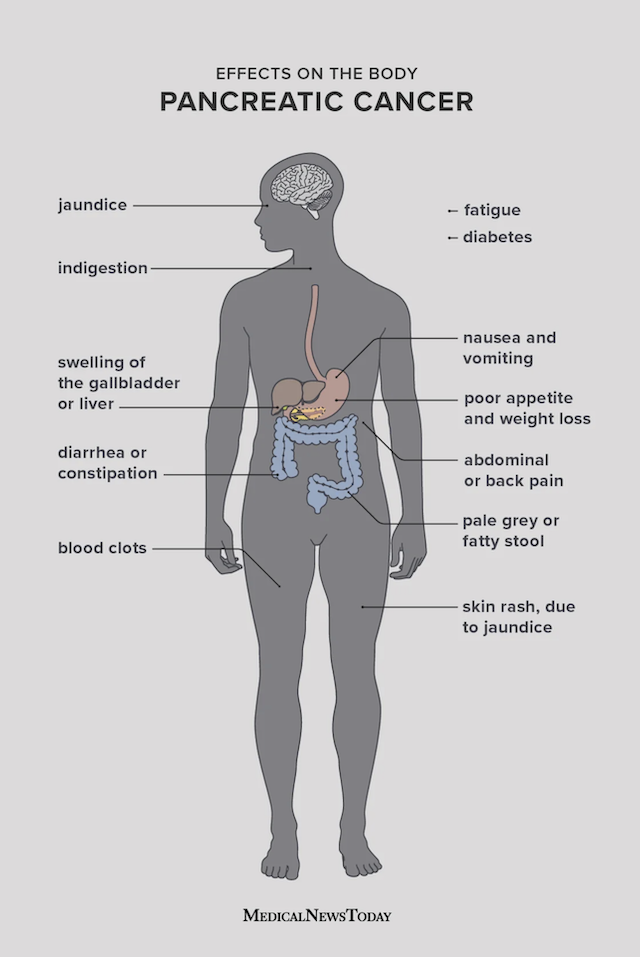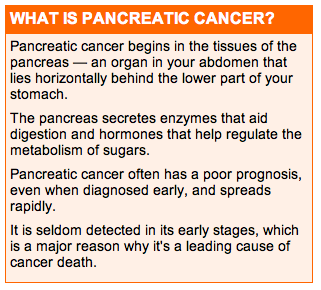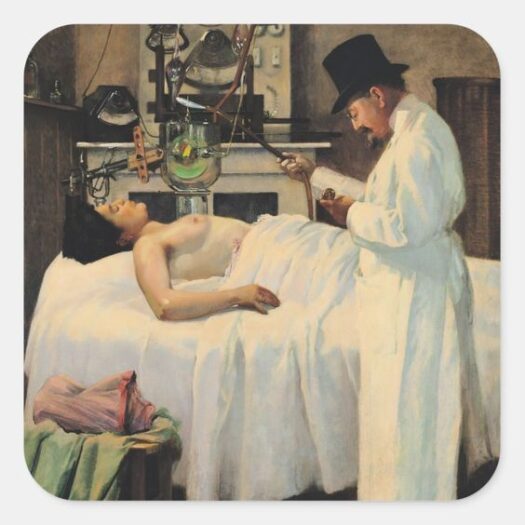 Pancreatic cancer develops when uncontrolled cell growth begins in a part of the pancreas. Symptoms include jaundice and pain located in the abdomen or back, but these might not appear until the later stages.
Pancreatic cancer develops when uncontrolled cell growth begins in a part of the pancreas. Symptoms include jaundice and pain located in the abdomen or back, but these might not appear until the later stages.
The pancreas is located behind the stomach in the back of the abdomen, near the gallbladder. It contains glands that create hormones, including insulin, and enzymes.
According to the American Cancer Society (ACS), around 3% of all cancers in the United States are pancreatic cancers. In 2021, the ACS expects around 60,430 people to receive a diagnosis of pancreatic cancer.
In this article, learn more about the signs and symptoms of pancreatic cancer, as well as the causes, treatment options, and outlook.
~ Symptoms ~
 The symptoms of pancreatic cancer often do not appear until the later stages. They can also resemble the symptoms of other conditions, which can make diagnosis more challenging.
The symptoms of pancreatic cancer often do not appear until the later stages. They can also resemble the symptoms of other conditions, which can make diagnosis more challenging.
Some common symptoms include:
* abdominal or back pain
* jaundice, which is present in around 70% of people with this type of cancer
* low appetite and weight loss
* swelling of the gallbladder or liver
* blood clots, deep vein thrombosis, or pulmonary embolism
* diabetes
* pale gray or fatty stool
* fever and chills, in some cases
* fatigue
* diarrhea ot constipation
* a rash due to jaundice
If the cancer spreads, new symptoms can appear elsewhere in the body. What other problems can affect the pancreas? Find out HERE!
~ Causes and Risk Factors ~
 Scientists do not know exactly what causes pancreatic cancer, but some factors appear to increase the risk.
Scientists do not know exactly what causes pancreatic cancer, but some factors appear to increase the risk.
Genetic factors
There is some evidence to suggest that the condition may run in families.
Genetic conditions that may have links to pancreatic cancer include:
* von Hippel-Lindau syndrome
* Peutz-Jeghers syndrome
Can genetic tests help predict or diagnose pancreatic cancer? Find out HERE!
Sex and age
Pancreatic cancer affects more males than females. This year, the ACS expects 31,950 males and 28,480 females to receive a diagnosis.
Although pancreatic cancer can occur at any age, including during childhood, it is more likely to appear after the age of 55 years.
Exposure to environmental toxins
Exposure to chemicals used in dry cleaning or metalworking may increase the risk of pancreatic cancer.
Other medical factors
People with the following health conditions may have a higher risk of pancreatic cancer:
* cirrhosis, or scarring of the liver
* infection of the stomach with the ulcer-causing bacterium Helicobacter pylori
* diabetes
* obesity
* chronic pancreatitis or inflammation of the pancreas
 Lifestyle factors
Lifestyle factors
Some lifestyle factors may also contribute to the development of pancreatic cancer, such as:
* smoking
* having excess weight
* getting low levels of exercise
* eating a diet that is high in red meat and fat and low in fruits and vegetables
* drinking a lot of alcohol over time
* consuming two or more soft drinks per day
~ Racial Inequities and Pancreatic Cancer ~
In the U.S., Black Americans are more likely to develop pancreatic cancer than any other group, statistics show.
The authors of one 2019 study note that the most likely explanation for this is social inequality. This impacts outcomes in various ways, including the availability of effective treatment options. This inequity affects both Black and Hispanic Americans.
The Pancreatic Cancer Action Network urges Black Americans to participate in clinical trials. This not only gives them access to treatment that might otherwise be unavailable, but it also increases the likelihood of research taking Black people’s needs into account.
~ Stages and Outlook ~
The outlook for pancreatic cancer depends partly on which stage it is at when a doctor diagnoses it. A cancer’s stage refers to how far it has spread.
For pancreatic cancer, the stages are:
Stage 1: The cancer is in the pancreas. It is localized.
Stage 2: The cancer has reached the bile duct and other structures but not the lymph nodes. It is regional.
Stage 3: The cancer affects the lymph nodes but is still regional.
Stage 4: The cancer has reached other organs and parts of the body. It is distant.
According to the ACS, a person who receives a diagnosis of pancreatic cancer has the following chances of surviving for another 5 years or longer compared with someone who does not have the condition:
* 39% when it is localized
* 13% when it is regional
* 3% when it is distant
In the early stages, treatment may be able to remove the cancer from the pancreas. As the cancer progresses, however, this becomes more challenging.
According to one article, in around 23% of people with pancreatic cancer, the tumor is localized at the time of diagnosis. However, about 52% of people receive a diagnosis when it has already spread to other parts of the body.
What is advanced, or stage 4, pancreatic cancer? Find out HERE!
~ Treatment ~
The treatment options for pancreatic cancer will depend on:
* the type of pancreatic cancer a person has
* its stage
* the person’s age, overall health, and other characteristics
* their personal choices
Treatment aims to:
* remove the cancer
* delay or stop its progress
* relieve the symptoms
 Surgery
Surgery
If the cancer is localized at the time of diagnosis, it may be possible to eliminate the cancer cells by removing all or part of the pancreas.
The three main surgical procedures for pancreatic cancer are:
Whipple procedure
In a Whipple procedure, a surgeon removes the pancreas head and sometimes the whole pancreas, along with a portion of the stomach, duodenum, lymph nodes, and other tissue.
Complications include leaking, infections, bleeding, and stomach problems.
Distal pancreatectomy
In distal pancreatectomy, the surgeon removes part of the pancreas and usually the spleen as well.
The spleen supports the immune system, so there may be a higher risk of infection after its removal.
Total pancreatectomy
In total pancreatectomy, the surgeon removes the entire pancreas and spleen.
A person can live without a pancreas, but diabetes may develop because the body no longer produces insulin cells.
Palliative surgery
Palliative surgery can help relieve symptoms such as obstructions in the bile duct or duodenum.
A surgeon can create a bypass so that bile can continue to flow from the liver. This can minimize pain and digestive problems.
Another option is to insert a small stent in the bile duct to keep it open. This is a less invasive procedure using an endoscope.
Can a person live without a pancreas? Find out HERE!
Embolization
In embolization, a healthcare professional will inject into an artery a substance that stops blood from reaching the cancer cells. Without the blood supply, these cells will die.
Side effects of embolization include abdominal pain, nausea, fever, infections, and a risk of blood clots in the area of the injection.
Ablation
Ablation uses heat or cold to destroy a tumor. It may help with tumors that are smaller than 1 inch (2.5 centimeters) across. A surgeon will insert a needle or a probe to apply the treatment.
Possible side effects include pain, infections, and internal bleeding.
Chemotherapy
Chemotherapy is a drug treatment that can kill cancer cells and stop them from spreading. A doctor may prescribe it alone or with other treatments. This treatment can also help relieve symptoms in the later stages.
A person receives treatment in cycles of 2-3 weeks, followed by a rest period. This allows the body time to heal between doses.
Side effects include hair loss, nausea, vomiting, and fatigue.
For an intense series of columns regarding Chemotherapy, please visit Dr. Kelley’s category, WARNING: Chemotherapy ~ Editor
Targeted therapy
his is a newer approach than chemotherapy. It stops cancer cells from developing by targeting substances they need to grow.
There are different types of targeted therapy, such as:
* EGFR inhibitors, which block the EGFR protein
* PARP inhibitors, which block PARP enzymes
* NTRK inhibitors
Unlike chemotherapy, these drugs have specific targets, so their impact on the whole body is lessened. However, they can still have adverse effects, which will depend on the type of treatment a person receives.
Immunotherapy
Immunotherapy works by helping the body’s immune system recognize and destroy cancer cells.
PD-1 inhibitors are one type of immunotherapy that may help treat pancreatic cancer. People receive this treatment as an infusion once every 2–3 weeks.
Possible side effects include fatigue, a cough, a rash, and joint pain.
Radiation therapy
Radiation therapy destroys cancer by focusing high energy rays on the cancer cells. It can shrink or remove a tumor. In the later stages, it can help relieve symptoms by removing or reducing a blockage.
Like chemotherapy, it can cause some side effects, such as skin changes, gastrointestinal disturbances, and fatigue. However, these usually pass after completing treatment.
A person may receive radiation therapy either alone or with other treatments, usually on 5 days per week for several weeks.
For an intense series of columns regarding Radiation, please visit Dr. Kelley’s category, DANGER: Radiation ~ Editor
~ Types ~
There are different types of pancreatic cancer. The main distinction is whether they affect the exocrine glands or the endocrine glands.
Exocrine pancreatic cancer
The exocrine glands produce enzymes that enter the intestines and help digest fat, proteins, and carbohydrates. Most of the pancreas consists of exocrine glands.
Types of tumor that can affect exocrine function include:
* acinar cell carcinomas
* cystic tumors
Most pancreatic tumors affect exocrine function.
Endocrine pancreatic cancer
The endocrine glands are small clusters of cells known as the islets of Langerhans. They release the hormones insulin and glucagon into the bloodstream. There, they help manage blood sugar levels. Problems with these glands can lead to diabetes.
The name will depend on the type of hormone-producing cell where the cancer starts.
Some examples include:
* insulinomas (insulin)
* glucagonomas (glucagon)
* gastrinomas (gastrin)
* somatostatinomas (somatostatin)
Knowing the exact type of cancer a person has will allow a doctor to provide the most appropriate treatment.
~ When to Contact a Doctor ~

The First Attempt to Treat Cancer with X Rays
Symptoms of pancreatic cancer often do not appear until the later stages.
Anyone who experiences jaundice should contact a doctor right away. Anyone who has other unusual symptoms for 4 weeks or longer should also seek medical advice.
~ Diagnosis ~
A doctor will ask about symptoms, take a family and medical history, and carry out a physical examination. They may also recommend some tests.
Tests
Some tests that a doctor may recommend include:
* blood tests, including a liver function test
* urine and stool tests
* imaging tests, such as X-rays, ultrasound scans, or MRI scans
* a biopsy to confirm a diagnosis
How can Medicare help with pancreatic cancer? Find out HERE!
~ Conditions With Similar Symptoms ~
Before making a diagnosis, a doctor will need to rule out other possible causes of the symptoms.
These could include:
* chronic pancreatitis
* cholangitis
* peptic ulcer disease
~ Prevention ~
No specific measure can prevent pancreatic cancer, but some lifestyle choices can help reduce the risk.
These include:
* quitting smoking, if applicable
* maintaining a moderate weight
* exercising often
* eating plenty of fresh fruits and vegetables
* limiting one’s intake of red meat
Can vitamin supplements help?
Scientists have looked into whether or not taking vitamins might help reduce the risk of pancreatic cancer.
For example:
* Experts have linked vitamin D with a lower risk of several types of cancer, including pancreatic cancer.
* One 2018 review supported the use of vitamin D. The authors also proposed that vitamin B12 could be beneficial.
* According to the authors of one 2020 review, a high intake of vitamin B6 may offer some protection against pancreatic cancer.
However, there is not enough evidence to confirm that taking supplements can reduce the risk of pancreatic cancer.
~ Summary ~
Receiving an early diagnosis of pancreatic cancer can improve the outlook, but this is not always possible because many people do not experience any symptoms until the later stages.
People who may have a higher risk of pancreatic cancer may wish to speak with a doctor about tests. There are no screening guidelines for pancreatic cancer, but a doctor may be able to advise people with a strong family history of the condition on genetic and other types of testing.
RELATED… What is the survival rate for pancreatic cancer?
Written by Yvetter Brazier and Medically reviewed by Alana Biggers, M.D., MPH for Medical News Today ~ May 25, 2023
